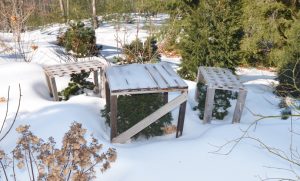

 The smaller plant material can be protected by wooden frames which we build to size. The frame is built out of two by four and the top is made of one inch by three inch boards, spaced no more than one inch apart. Cross braces are used for sturdiness.
The smaller plant material can be protected by wooden frames which we build to size. The frame is built out of two by four and the top is made of one inch by three inch boards, spaced no more than one inch apart. Cross braces are used for sturdiness.